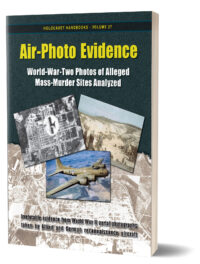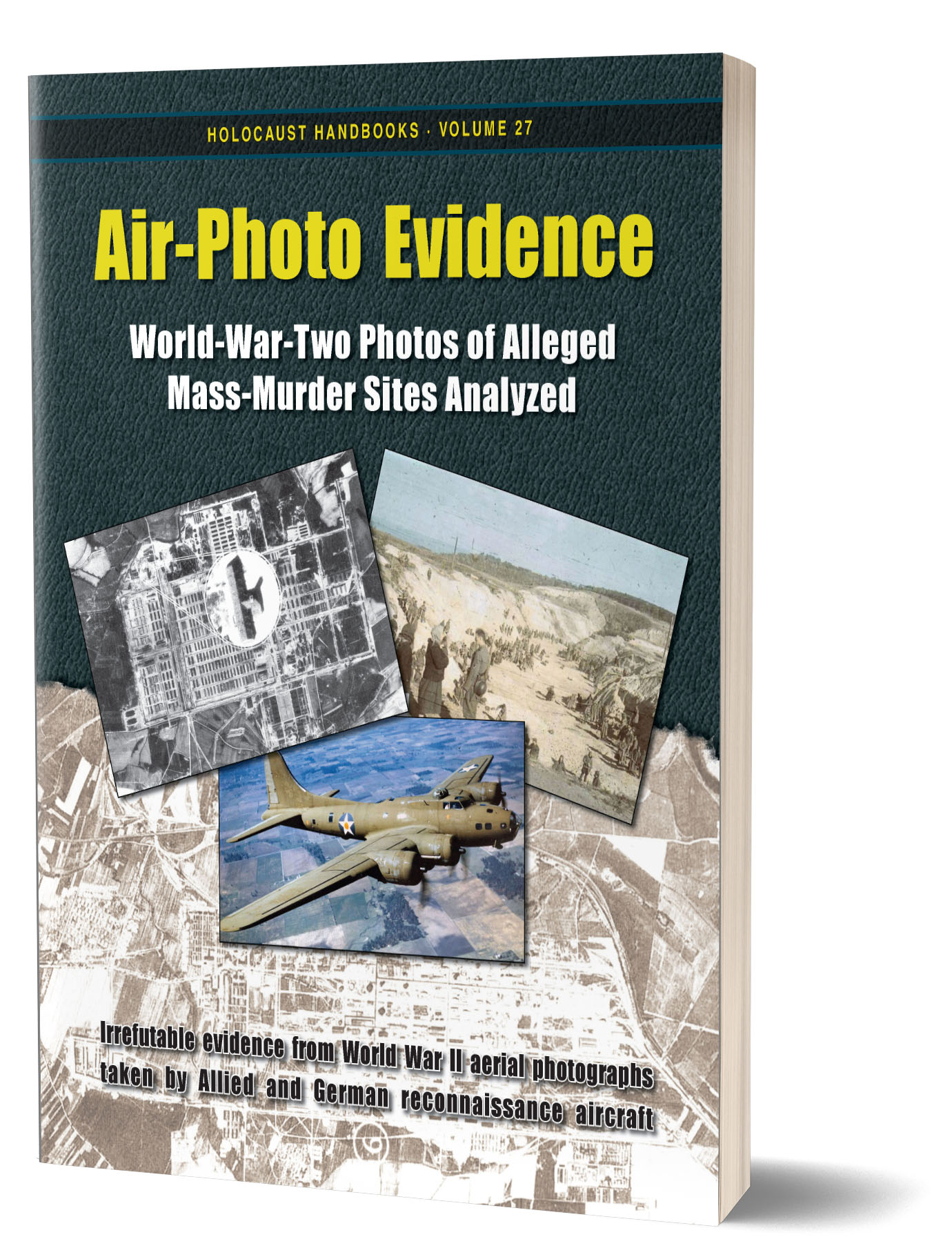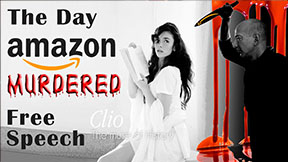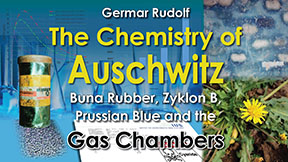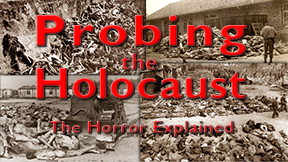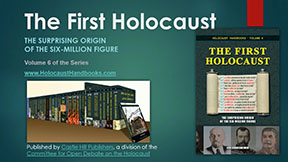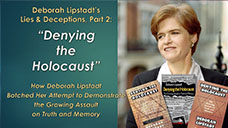I remember the day when I held John C. Ball’s seminal 120-page letter-size book Air Photo Evidence (1992) in my hands. It blew my mind. Who could possibly resist the convincing power of air photos mainly taken by Allied war planes over sites claimed to have been the locations of Nazi mass murders? After the Leuchter Report, I think it was this very work which struck the most fatal blow to the orthodox Holocaust narrative. In 2014, I decided to get it back into print. Below is the Foreword I wrote for its 2018 edition. And after that, you can read how the current edition is being advertised at www.HolocaustHandbooks.com:
Foreword
In his 1976 book The Hoax of the Twentieth Century, Dr. Arthur R. Butz explained in detail that, during the Second World War, the German industrial activities around the infamous Auschwitz concentration camp were of great strategic importance to the Allies. Hence he concluded that Allied reconnaissance aircraft must have taken many photos of the area, which to this day could be very revealing regarding the true nature of the Auschwitz Camp, as certain activities claimed by many eyewitnesses would have been so vast that they could not have been missed by Allied intelligence.[1] But no such photos had been released by 1976. That changed three years later, when the U.S. Central Intelligence Agency published a slender brochure containing a few such aerial photos. The authors (Brugioni/Poirier) claimed that these photos do indeed prove the claims made by many witnesses in terms of containing evidence for an ongoing mass murder. At that time, revisionism was not yet well organized in the Anglo-Saxon world, so no thorough refutation of the CIA’s claims was published at that time in English. I know only of reactions by German revisionists who undertook to debunk the CIA’s claims (see Stäglich & Walendy.)
The matter changed in 1992 when John Clive Ball published the first edition of the present book. This book was a game changer. Rather than reacting to what others had claimed, it set a new standard of historical forensics by which all future publications about the Holocaust had to be tested.
Almost every revisionist book that appeared after Ball’s epoch-making study also included analysis of relevant air photos. The most important book in this regard is probably Mattogno’s Auschwitz: Open-Air Incinerations. It investigates the claims made by many Auschwitz witnesses that, from May through August 1944, gargantuan cremation pyres in huge pits were burning day and night at the Auschwitz-Birkenau Camp, upon which the corpses of hundreds of thousands of murdered Hungarian Jews were being turned into ashes. It is claimed that during this time the entire area was blanketed in thick smoke. Of course pictorial evidence of such large undertakings would have been captured on air photos taken by Allied reconnaissance planes. But as the reader of the present study will discover, the extensive photos of the place and time show nothing unusual at all.
It goes without saying that some of the few orthodox historians who dared to confront revisionist research had to deal with these air photos as well (foremost Shermer/Grobman and Zimmerman), although their attempts at papering over the huge cracks in orthodox historiography were swiftly exposed as seriously flawed by leading revisionists.[2]
A few more air photos of the Auschwitz Camp taken by the Allied and German air forces have been discovered since the first edition of the present study had appeared, but they show much the same thing. A few of them require our attention, though, as they show a column of smoke rising from a small area of the Birkenau Camp. I have added them and a brief discussion of what we see there to Chapter 5.9. Also, the subject of massive open-air incinerations allegedly going on between mid-May and late summer 1944 in an area west of the Birkenau Camp near the so-called “Bunker 2” – a makeshift homicidal gas chamber of legendary proportions – has been dealt with in this new issue with the new Chapter 5.10. It also features two new air photos. None of them show any smoke in this area, though, hence no trace of any incinerations at all…
In 1994, a paper by John Ball was published which summarized the present book and added a few more aspects, which the interested reader might want to consult as well.[3] One particularly interesting issue is Ball’s suspicion that the air photos released in 1979 by the CIA have been tampered with, as he describes in the present book (Chapter 5.4). In his 1994 paper he wrote about this:[4]
“After realizing these facts of the matter, I went to the National Archives and requested to see the originals, since the photos given to me as originals had clearly been altered. And in fact I was then given air photos which I was assured were the originals. These were indeed of better quality than the negatives I had been given first: due to the better focus, the work of the forgers was considerably more clearly apparent at the same places on the photos. When I pointed this out to the Archives staff, I was told that these were the negatives which the National Archives had received from the CIA in 1979, and that they had always believed that they were in the precise state in which they had been taken from the reconnaissance planes in 1944. I was told that I was the first member of the public ever to have seen these negatives. Now they would be returned to the archives forever, to be handed out only at the request of government agencies such as the CIA.”
A year later, an Austrian publication attacked Ball for these statements, insinuating that these negatives are available to anyone on request:[5]
“He [Ball] surrounds this claim [re. the alterations] with a graphic account of his research in the National Archives in Washington, where these photos, he claims, are now locked away for all time because he had proved that they were falsified. He withholds from his readers the fact that these same photos may be viewed in the State Museum of Auschwitz […]”
It is needless to say that there can be only one original negative of each photograph, namely the one that was in the camera when the photo was taken (and which the CIA might have destroyed). All the other negatives are copies, of which in this case many may exist at various locations, each of them of course subject to loss of quality and alteration.
An interesting episode about the question whether or not these air photos have been tampered with occurred in the context of the second Zündel trial.[6] During that time, Dino Brugioni approached Ernst Zündel privately and told him “off the record” that he himself does not believe that the air photos published by him prove the orthodox Holocaust narrative and that he, too, has the suspicion that the photos he was given by his superiors to analyze in 1979 had been tampered with.[7] For me, of course, this is not much more than hearsay, so not much weight can be put onto it.
Fact is, however, that in 1999 Brugioni published a book entitled Photo Fakery which explored “The History and Techniques of Photographic Deception and Manipulation,” according to the subtitle of the book. The book exposes and explains a wide variety of tampered-with photos of political importance. Only one set of photos in the entire book is claimed to be original, untampered and authentic: the Auschwitz air photos Brugioni had published 20 years earlier. Why would Brugioni include those exceptions in a book about forgeries which otherwise doesn’t even remotely touch upon the Holocaust topic?[8]
I leave that to the reader’s imagination.
John Ball and I started working on a new edition of his book in late 2003/early 2004, when he started sending me new aerial photos not discussed in the first edition of the present study. At that time we also considered enabling the reader to look at some of the Auschwitz air photos taken in rapid succession with 3D glasses in order to get a three-dimensional impression. The project was delayed, as I was working on other projects, and then, in October 2005, I was actually arrested by the U.S. authorities and deported back to Germany, allegedly for an immigration violation, but really because my revisionist work had made me many powerful enemies (see Rudolf, Resistance Is Obligatory). At that time three other leading revisionists were also thrown in jail (Ernst Zündel, Siegfried Verbeke, David Irving). Although that is an entirely different story, fact is that John Ball got scared by this sudden spike in persecution of peaceful dissidents. Around that time, he decided to quit revisionism, hand over all material to others who wanted to continue, move to a different place, start a different business, and change his name. Only in early 2015, after I had published the greatly improved 3rd edition of the present book, did John Ball contact me. Since most of the material in this book is in the public domain for which John could not claim any copyright, and because he still did not want to get re-involved in, or associated with, revisionism, he asked me to remove his name from this new edition and use someone else’s. He also told me that he could not help me with getting the original photo prints used to prepare his first edition, because in 1994 he had given them all to Ernst Zündel on his request, but when Zündel’s home in Toronto was fire-bombed a year later, all the prints went up in flames. Therefore, for this edition, too, we will have to make do with the professionally prepared high-resolution scans of the images reproduced in the first edition. Quality losses are minimal, and the results visible in the present print-on-demand book are good enough for most of us. Those who want to seriously explore this issue in more depth are advised to get prints from the archival resources mentioned, though.
The present study has 168 pages, 48 more than the first edition. This is due not only to the fact that I have included a few more air photos addressing issues not discussed in earlier editions of this work – as mentioned before – but also because all the pertinent material which John Ball had published in his 1993 16-page brochure The Ball Report has been integrated. That brochure consisted mainly of Ball’s schematic drawings of the crime scenes investigated plus a brief summary of chemical analyses of wall samples he had taken at Auschwitz in early 1993. I have expanded that subject with a brief introduction into the relevance of analyzing such samples, and by summarizing the analytic results obtained by other authors who preceded Ball with their sampling.
Several sections of Ball’s original work have been extensively edited for this current edition, as they were erroneous to the point where keeping them as they were would have been irresponsible. Writing this, I do not mean to criticize Ball for the mistakes he made back then. In the early 1990s, John Ball was a novice in Holocaust research (as was I at the time). It was therefore to some degree inevitable for him to make a number of mistakes. Some of them he might have avoided, had he communicated with more-experienced researchers in the field prior to publishing the first edition of his book. Other errors, however, became apparent only due to subsequent research published in later years, upon which I could rely for this edition.
One of these issues – whether the black lines around the Birkenau crematoria are due to thick fences or the result of CIA manipulations – is addressed in this edition by Carlo Mattogno. He shows that the Auschwitz camp authorities planned to surround the crematoria with vegetation making them less conspicuous to the inmates, and a post-war photo indicates that at war’s end a makeshift fence of tree branches was indeed present around at least one of the crematoria, or rather its ruins. I doubt, though, that such a slender fence of twigs and branches could produce the thick dark lines on the air photos, which look more like massive, thick walls. For this reason, I keep Ball’s original suspicion of manipulations as it is.
There have been two noteworthy reactions by experts to Ball’s findings, one by Nevin Bryant, supervisor of Cartographic Applications and Image Processing Applications at NASA’s Jet Propulsion Laboratory in Pasadena, California, the other by Carroll Lucas, an expert of air-photo interpretation with 45 years of experience working for the biggest criminal organization in the world, the CIA.
We know of Bryant’s expert opinion only through what other wrote about it,[9] which was pretty much limited to identifying several groups of inmates visible on the photos. Of course, in a camp housing many thousands of inmates, and during late spring and early summer 1944 at times perhaps even more than a hundred thousand, you would expect to see many groups of inmates moving about outdoors. That proves nothing. In that context, Shermer and Grobman committed a minor blunder about the so-called “moiré effect” which I address here on p. 63. (I am sure that Bryant would not have endorsed such nonsense.) Interestingly, Shermer and Grobman – and with them probably also Bryant – are completely silent about any outdoor cremations, even though that ought to be the primary focus of any air-photo analysis, as such cremations would be highly visible and would allow gauging the order of magnitude of the claimed events unfolding at Birkenau in 1944.
Lucas’s 23-page report was published in its entirety (Zimmerman, pp. 276-298), but surprisingly he does not reproduce any air photo, and thus offers nothing at all to back up his claims and conclusions. Regarding outdoor cremations, he correctly points out that small smoke plumes are visible on some photos (Zimmerman, p. 290; see several such photos on pp. 97-101 in this study), but he neglects to compare those small fires with the kind of pyres that would have been needed if the claimed daily outdoor cremation of thousands of gassing victims had really happened. As Mattogno has shown,[10] Lucas was apparently harassed by Zimmerman to make statements which are not supported by the evidence, like the claim that storage barracks are visible near the so-called Bunker 2 on a photograph of May 31, 1944, when later images clearly show that these storage barracks were built only subsequently (Zimmerman, p. 299; see p. 119 in this study). That leads me to believe that Lucas’s analysis was not an expert report but rather a report of complaisance. At any rate, he, too, failed to find evidence for mass murder.
With this, please enjoy reading this fine pioneer work of Holocaust revisionism in its latest, revised edition.
At this point, I wish to express my gratitude to Jett Rucker for carefully proofing this study, to John Ball for sending me scans of his original hand-drawn maps and schematic drawings, to Hannes Metzner for his constructive criticism,[11] and last but not least to Carlo Mattogno for his critical and constructive peer review, in particular for his input regarding potential mass graves near the Auschwitz-Birkenau Camp as discussed in Section 5.13, as well as for writing his short essay on the crematoria fences added to this study on pp. 70-74.
Germar Rudolf, March 16, 2017
[1] In the 4th U.S. edition of 2015, see the chapter “Auschwitz of Great Interest to Americans,” pp. 85-89, and “Where are the pictures?”, pp. 202f.
[2] See Carlo Mattogno, “Denying Evidence,” in: Rudolf/Mattogno, pp. 203-280, in particular pp. 236-245; and “The Elusive Holes of Death,” ibid., pp. 291-407; especially pp. 303-305, 380-384.
[3] John C. Ball, “Luftbildbeweise,” in: Gauss, pp. 235-248; English: “Air Photo Evidence,” in: Rudolf, Dissecting the Holocaust, pp. 269-282.
[4] Here quoted from the English ed., ibid., pp. 278f.
[5] Bailer-Galanda/Benz/Neugebauer, p. 25 (translation mine).
[6] On that trial see Kulaszka.
[7] Ernst Zündel, private communication.
[8] See the review by Widmann.
[9] Shermer/Grobman, pp. 143-153; similar van Pelt, p. 84.
[10] Auschwitz: Open-Air Incineration, 2nd ed., pp. 52f., 54-57, 65-79.
[11] http://holocaustcontroversies.blogspot.com/2015/02/john-balls-air-photo-evidence-on.html
Holocaust Handbooks, Volume 27:
Germar Rudolf (ed.): Air Photo Evidence—World War Two Photos of Alleged Mass Murder Sites Analyzed
6th, corrected edition
During World War Two both German and Allied reconnaissance aircraft took countless air photos of places of tactical and strategic interest in Europe. These photos are prime evidence for the investigation of the Holocaust. Air photos of locations like Auschwitz, Majdanek, Treblinka, Babi Yar etc. permit an insight into what did or did not happen there. This then can be compared with what witnesses claim happened there. The present book is full of air photo reproductions and schematic drawings explaining them. According to the author, these images refute many of the atrocity claims made by witnesses in connection with events in the German sphere of influence.
Auschwitz
Witnesses have claimed that, in the spring and summer 1944, the chimneys of the four crematories at Auschwitz-Birkenau were constantly smoking profusely and that thousands were incinerated on pyres in huge outdoor pits. The air photos presented here show whether they are right. An analysis of these photos further reveals that someone tampered with copies of them in an attempt to add into the pictures what should be there but isn’t …
Babi Yar
After German units captured the Ukrainian capital Kiev, they are said to have shot some 33,000 Jews and tossed them into the Babi Yar ravine. In the summer of 1943, shortly before their retreat, the Germans are said to have exhumed the bodies and burned them for weeks on huge stakes. What do air photos from before and immediately after the event show?
Belzec, Sobibor, Treblinka
Witnesses claim that in these camps altogether more than 1.5 million Jews were killed and initially buried in gargantuan mass graves. Later on they are said to have been disinterred and burned on huge pyres. Do the air photos show any evidence for this to be true, like remnants of huge mass graves, charred earth from huge fires?
Majdanek
This was the first major German concentration camp “liberated” by the Red Army toward the end of World War II. Initially it was claimed that up to 1.7 million inmates were killed here by various means, but that number has decreased over the past seven decades to just under 80,000. Also decreased is the number of officially alleged gas chambers used for these claimed murders: from seven to currently two. The air photos presented here give some clues as to why these mass murder claims have been untenable from the start.
6th, corrected edition.
Learn more about this book here, which is available in ebook, auto book and print formats.
| Item Properties | |
|---|---|
| Published by: | Uckfield: Castle Hill Publishers |
| ISBN: | 978-1-59148-247-5 |
| Pages: | 184 |
| Edition No.: | 6, corrected |
| Release Date: | 5/2020 |
| Illustrations: | 264 b+w |
| Features: | Index, Bibliography |

